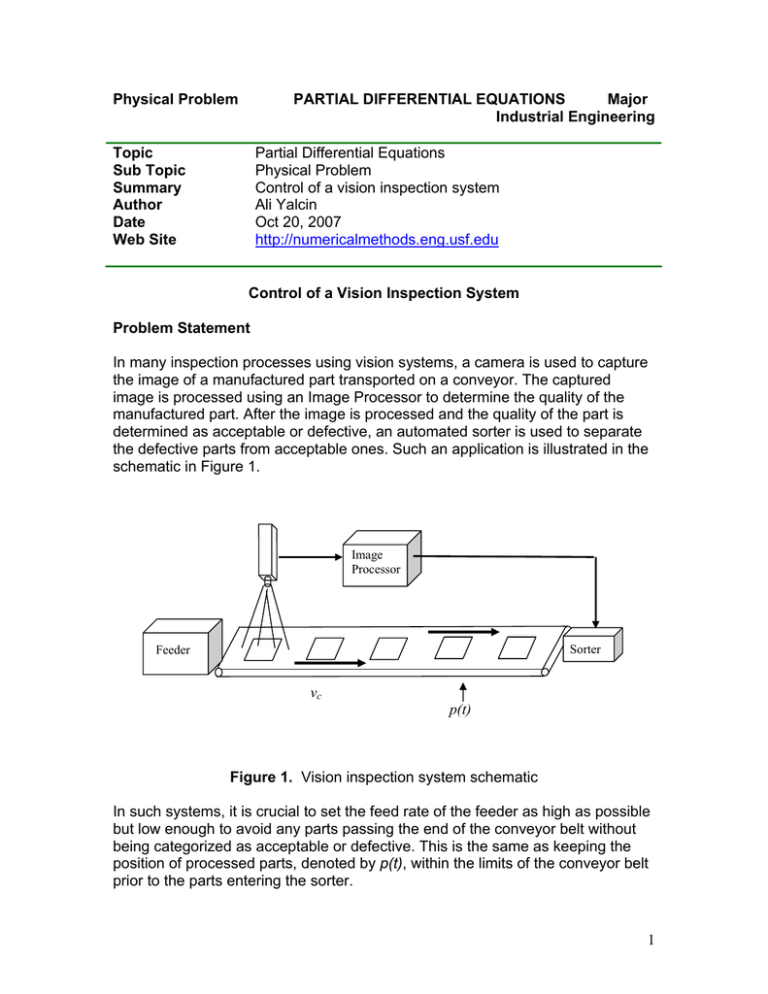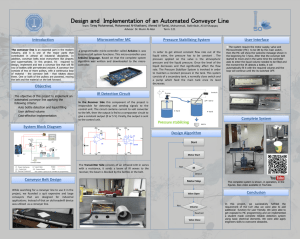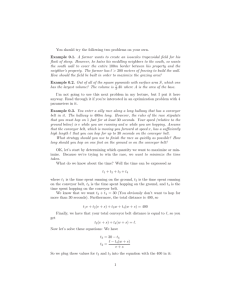Partial Differential Equations Physical Problem Control of a vision inspection system
advertisement

Physical Problem PARTIAL DIFFERENTIAL EQUATIONS Major Industrial Engineering Partial Differential Equations Physical Problem Control of a vision inspection system Ali Yalcin Oct 20, 2007 http://numericalmethods.eng.usf.edu Topic Sub Topic Summary Author Date Web Site Control of a Vision Inspection System Problem Statement In many inspection processes using vision systems, a camera is used to capture the image of a manufactured part transported on a conveyor. The captured image is processed using an Image Processor to determine the quality of the manufactured part. After the image is processed and the quality of the part is determined as acceptable or defective, an automated sorter is used to separate the defective parts from acceptable ones. Such an application is illustrated in the schematic in Figure 1. Image Processor Sorter Feeder vc p(t) Figure 1. Vision inspection system schematic In such systems, it is crucial to set the feed rate of the feeder as high as possible but low enough to avoid any parts passing the end of the conveyor belt without being categorized as acceptable or defective. This is the same as keeping the position of processed parts, denoted by p(t), within the limits of the conveyor belt prior to the parts entering the sorter. 1 System Model In the above described vision inspection system, the number of parts placed on the conveyor by the feeder is equal to the number of parts processed by the sorter. In other words, no parts are removed from the line in the inspection process. Based on this notion, the inspection system can be characterized by a first order partial differential equation as ∂n( x, t ) ∂n( x, t ) + vc =0 ∂t ∂x (1) with boundary condition and initial condition f (t ) vc n ( x, t ) = n o ( x ) n(0, t ) = Where n( x, t ) is the concentration of parts on the transport belt (parts/feet) vc is the conveyor speed t is time x is the spatial coordinate variable f(t) is the feed rate of the feeder system (parts/second) no (x) is the initial covering of the conveyor belt The goal of the system controller is to set the feed rate of the feeder denoted by f(t) such that p(t) (the position where on the conveyor where the part is determined as defective or acceptable) is before the end of the conveyor belt. The velocity p& (t ) of the decision position is determined by r (t ) p& (t ) = vc − (2) n ( x, t ) Where r(t) is the processing speed of the image reader. When this capacity is divided by the concentration of parts at location x, and subtracted from the conveyor speed, the velocity of the decision point is determined. Controller Design The controller for such a system can be designed using several approaches, one of which is based on using optimal-time control as described in [1]. A brief summary of this work is as follows. For this system to operate within desirable 2 conditions without failing to detect defective parts, the feed rate of the feeder f(t) must be equal to the processing rate r(t) on average. Let loading of the line y(t) describe the number of parts not categorized by the reader. This quantity is determined by the simple differential equation y& (t ) = f (t ) − r (t ), y ≥ 0 In order to hold y(t) constant, a switching controller such as f (t ) = f maxσ ( w(t ) − y (t )) , where σ is a step function, is used. The feeder works at full capacity fmax as long as the load of the delay line is less than the reference signal w(t). When it exceeds the reference signal the feeder is stopped. In this manner, the feeder loads the line as quickly as possible when y(t) < w(t) and the system is emptied as quickly as possible when y(t) > w(t). QUESTIONS 1. Assume that such an inspection system has feed rate of 0.1 parts per second. The imaging process can identify defective/acceptable parts at a rate of 0.12 parts per second. The conveyor speed is set at 2 ft. per second and has a length of 30ft. Calculate the concentration of parts at the midpoint of the conveyor. Assume that there are no parts on the belt at the beginning of the process. REFERENCES 1. B. Lohman, “Throughput Control for a transport process, and an application in postal automation process”, Control Eng. Practice, 4(11), 1996, p. 1503-1509 3







